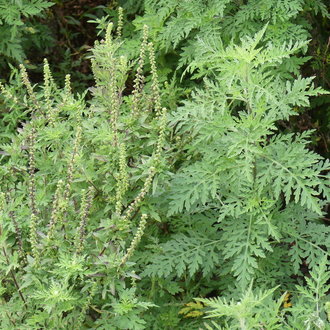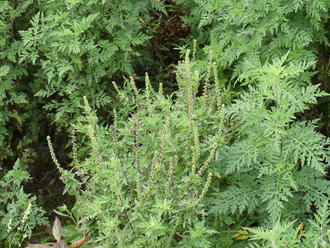Common Ragweed (Ambrosia artemisiifolia L.)
Also known as annual ragweed.
↑Summary
This species is native to the Americas. According to the USDA, in North America there are both locally-native populations, limited to the Southeast, and adventive populations which have expanded from Canada southward. It is a major allergen, although it produces less pollen than giant ragweed (Ambrosia trifida). Has become an invasive species on other continents.
↑Range - Expand
| Legend | Color |
| Native | |
| Expanded | |
| Native or Not Present | |
| Native or Expanded | |
| Expanded or Not Present |
This tentative map is based on our own research. It may have limited data on Canada and/or Mexico, and there is some subjectivity in our assignment of plants as introduced vs. expanded. Read more in this blog post.
Although this plant occurs somewhere in each of these regions, it may only occur in a small part of some or all of them.
It is not known exactly where this species is native, but it is widely agreed to be native to North America, and that its range has expanded. POWO reports a much wider native range but this is in conflict with many regional sources including Calflora. Our map is based on BONAP's reported native range which is more in agreement with other sources than POWO. This species has also expanded into northwest Mexico, and is also native to Canada and likely also expanded into more of Canada as well, and we have yet to build the portions of its map outside the lower 48 US.
↑Habitat
Found in full sun, and average to dry conditions. Occurs in a wide range of soil types, but on richer sites, usually only occurs where disturbance removes competition from other plants. Tolerant of some salinity, which enables it to thrive along roadsides. Some populations may have developed herbicide resistance.
In much of its range, found mostly in anthropogenic habitats, especially cultivated or fallow fields, roadsides, and waste ground.
↑Life Cycle
This species is an annual. Seeds germinate in the spring after a period of cold dormancy, and usually only germinate when close to the surface and exposed to high light conditions.
Plants begin to bloom late summer and continue into the early fall. Unlike most plants of the Heliantheae tribe, this genus is wind pollinated.
Seeds production is large, and seeds remain viable for several years, often only germinating in response to disturbance that produces exposed soil and high-light conditions. This life cycle is optimally suited for many anthropogenic habitats, including both agriculture and roadsides.
↑Uses
This plant is mostly viewed as an unwanted weed and allergen.
Used by some native Americans for medicinal purposes, and occasionally used in bioremediation, as it is tolerant of various types of polluted soils.
↑Related Plants
Numerous other Ambrosia species, mostly native, occur across North America. Able to hybridize with A. trifida, producing the hybrid Ambrosia ×helenae, which is rare, only recorded on a few isolated sites.
The broader Heliantheae tribe contains many plants, most of which have showy flowers and do not resemble the Ambrosia genus visually.
↑Links & External Resources
• Ambrosia artemisiifolia (Common Ragweed) | Illinois Wildflowers (About This Site)
• Ambrosia artemisiifolia (Common Ragweed) | USDA PLANTS Database (About This Site)
• Ambrosia artemisiifolia | Go Botany (About This Site)
• Ambrosia artemisiifolia | Biota of North America Project (BONAP) (About This Site)
• Ambrosia artemisiifolia | NatureServe Explorer (About This Site)
• Ambrosia artemisiifolia | Flora of North America (About This Site)
• Ambrosia artemisiifolia | Missouri Plants (About This Site)
• Annual Ragweed | Maryland Biodiversity Project (About This Site)
• Ambrosia artemisiifolia (Common Ragweed) | Minnesota Wildflowers (About This Site)
• Ambrosia artemisiifolia L. | Plants of the World Online (POWO) (About This Site)
• Ambrosia artemisiifolia L. (Common Ragweed) | Digital Atlas of the Virginia Flora (About This Site)




